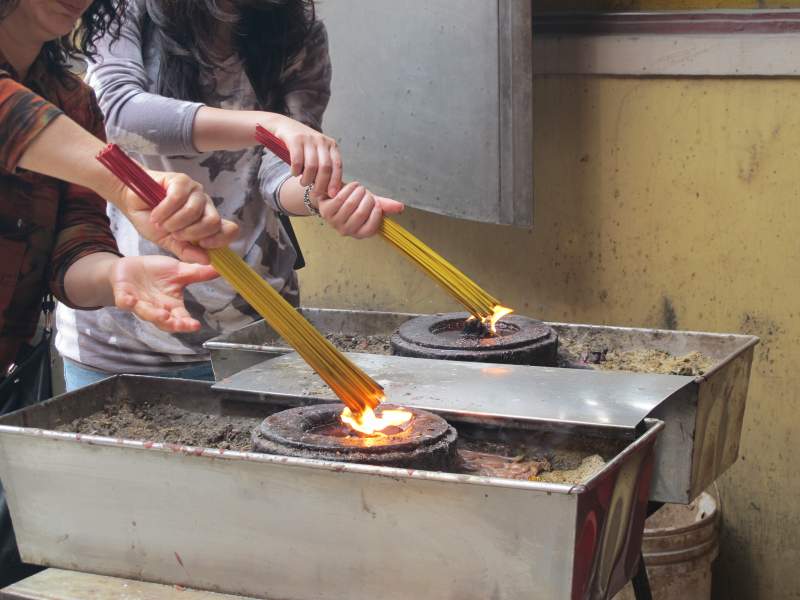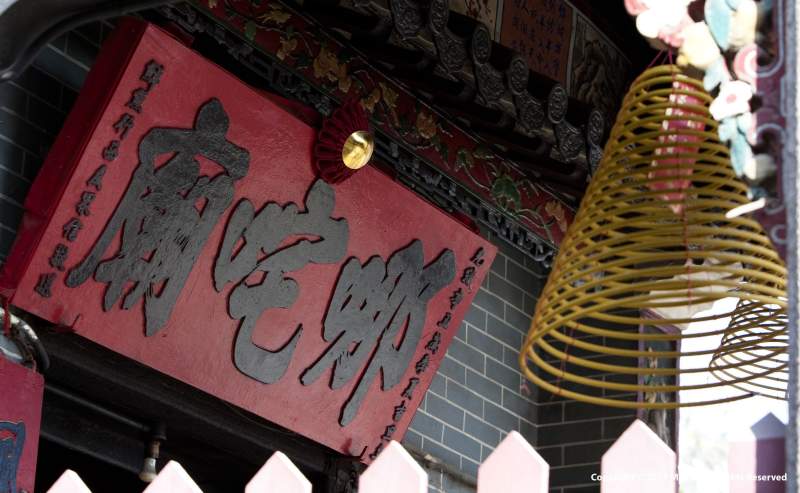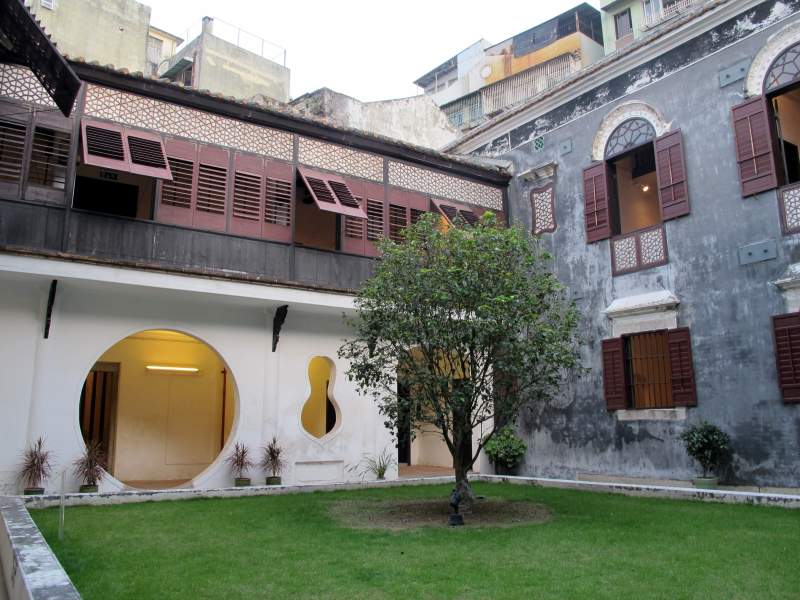I’m standing in Macau’s Senado Square, when an American couple asked, “What is there to see besides casinos?” “Pretty much anything you’d want!” I could have shouted, but probably the best thing I could have done is handed them this walking tour around St Paul’s ruins.
My love affair with Macau began in the 1980s when it was still under Portuguese rule before being handed back to the Chinese in 1999.
Its old-world charm is what lures me back, especially its historic neighbourhoods laced with narrow, winding streets leading past banyan-shaded squares, pastel-painted colonial architecture and ancient temples.
Scenes of everyday life seem unhurried and timeless, with the chatter of children in school uniform filling the air, elderly gathering in parks and plazas, and women returning from market with food for the evening’s meal.
Covering one of Macau’s oldest commercial districts, it leads from imposing Senado Square, considered the heart of the city, to the Ruins of St. Paul’s, Macau’s most iconic landmark, and also includes stops at a Chinese mansion, the informative Macau Museum, an old cemetery and gardens.
Settled by Portuguese traders in the mid-16th century in an area already occupied by Chinese farmers and fishermen, Macau fostered exchange between East and West for more than 400 years, reminders of which include traditional Chinese architecture and the oldest Western structures on Chinese soil.
There are lots of places to go in Macau that combines the traditions, architecture and cuisines of both China and Portugal.
Little wonder the Historic Centre of Macao was declared a World Heritage Site in 2005, with temples, churches, mansions, squares and other ancient monuments, urban spaces and familiar Macau tourist spots among its 30 protected sites.
I would have also recommended a walk through Macau’s Penha Peninsula, which snakes through the town’s oldest residential area and makes for an interesting contrast.
Together, both strolls introduce about half of the 30 temples, churches, museums, Chinese mansions, plazas and other structures that make up the Historic Centre of Macao, a World Heritage Site since 2005.
Both walks connect at Senado Square and can easily be combined into a five- or six-hour exploration of Macau.
For more ideas on what to do in Macau with kids see this Macau itinerary.
Walking tour around St Paul’s Ruins
1- Senado Square to Cathedral Square
There’s no mistaking Senado Square with its wave-patterned cobblestones, pastel-coloured colonial buildings and throngs of families and sightseers.
This has been the centre of Macau’s commercial life for centuries and is still used for public events and festivities.

Follow the wavy-patterned mosaic uphill to St. Dominic’s Church, one of Macau’s prettiest churches but also the scene of a murder.
Founded in 1587 by Spanish Dominican friars originally from Mexico, it witnessed violence in 1644 after the governor reneged on his promise to free Spanish prisoners.
After fighting broke out in the streets, an officer sympathetic to the Spanish sought refuge here during Mass, but a mob pursued him and stabbed him at the altar.
Today, this marvellous example of Baroque architecture is famous for that altar, with statues of Jesus and the Virgin Mary.
Stairs in the right corridor lead to the belfry, where three floors display religious artifacts; my favourite is the top floor, where a soaring ceiling exposes the building’s intricate construction.
Back outside, catty-corner to the right is narrow Travessa de S. Domingos, which leads uphill to Cathedral Square, where I like taking a break on a bench for people-watching.
The square is dominated by the Cathedral, which is an iconic landmark in Macau that has existed in various reincarnations since at least 1622 and once served as the mother church of a diocese that included China and Japan.
There are plenty of choices when looking for where to stay in Macau, from boutique hotels to glitzy casino resorts of the Cotai strip and a range of cheap hotels in Macau too.
2- Cathedral Square to Ruins of St. Paul’s
Downhill from Cathedral Square, on Travessa da Sé, is Lou Kau Mansion, built in 1889 by a Chinese merchant.
Though not nearly as grand as the Mandarin Mansion described in my other walk, it has decorative lattice carvings, plaster decorations and an inner courtyard.
It’s also easier to find, just a stone’s throw from the Cathedral and Senado Square, testimony to the ethnic harmony that existed between Macau’s Europeans and Chinese at the time.
Continue downhill and from Rua da Palha on the right side of St. Dominic’s Church, head uphill on Rua da S. Paulo, packed with pedestrians and lined with open-fronted shops selling the ubiquitous barbecued beef jerky and reproduction Chinese furniture.
Near the top of the hill is a grand set of stone stairs leading to Macau’s most famous landmark, the Ruins of St. Paul’s. And ruins they are, for in 1835 a fire destroyed the 17th-century church, leaving only the staircase and ornate façade behind.
Take time to study that façade, carved by Japanese Christian exiles and Chinese stonemasons and containing a wonderful mix of Asian and Western images, including a Portuguese ship, a skeleton, the Virgin Mary and a chrysanthemum.
Behind the façade is a crypt containing bones of 17th-century Japanese and Vietnamese Christian martyrs and the Museum of Sacred Art.


Beside St. Paul’s is the must-see Macau Museum, ensconced in the bowels of Mount Fortress, built in the early 1600s as the city’s primary military defence with supplies to survive a two-year siege.
The museum is a treasure trove for information on old Macau’s history, daily life and traditions ranging from cuisine to festivals in Macau.
The food in Macau is tasty and varied. While in Macau you may like to try Macanese cuisine. You might also like to read this guide to choosing a Macau restaurant.
3- St. Paul’s to Camões Square
On the opposite side of St. Paul’s is the diminutive Na Tcha Temple, erected in 1888 to help against plague and yet another example of the peaceful co-existence between Chinese and Europeans.
Beside it is the only remaining section of the old city wall, built as early as 1569 and incorporating clay, soil, sand, rice straw, crushed rocks and oyster shells.

Following the wall downhill, turn right and walk five minutes toward Camões Square, passing shops selling reproduction furniture and antiques and St. Anthony’s Church, first erected in 1558 as Macau’s first church and rebuilt in 1930.

4- Camões Square back to Senado Square


Across Camões Square is the Protestant Cemetery, with about 160 graves of mostly British and American Protestants, including artist George Chinnery, Joseph Adams (grandson of George Washington) and even opium traders, who were respected merchants at the time.
Nearby is Casa Garden, built in 1770 for a wealthy Portuguese merchant and later rented to the English East Asia Company, and Camões Garden, once part of Casa Garden’s estate and named after Portugal’s most famous poet, said to have lived in Macau in 1557 and honoured here with a bust in a small grotto. Elderly come for daily exercise or to play Chinese games in the back pavilion.
Return to Senado Square through the Tercena Neighborhood, where ma-and-pa shops sell everything from goods made from coconut products and to temple offerings, many with tables set up for mah-jongg.
Just before Senado Square, behind St. Dominic’s Church, is a street market with stalls selling children’s wear, Chinese jackets and other cheap clothing.
Walking tour around Penha Peninsula

This walking tour through Penha Peninsula, one of Macau’s oldest neighbourhoods and still largely residential, introduces what I consider Macau’s grandest colonial buildings, its most remarkable Chinese mansion and a few of my personal favourites.
5- A-Ma Temple to Mandarin’s House

Macau’s oldest temple was already here when the Portuguese landed in the 1550s, making this the oldest building in town.
It’s named after A-Ma, the goddess of seafarers, and because local Chinese called the area A Ma Gao (“Place of A Ma”), Portuguese settlers named their new home Macau.
Built along a steep hillside with winding pathways and moon gates, it has prayer pavilions dedicated to deities from Taoism, Buddhism and folk beliefs.
Across the street, about where the Portuguese first stepped ashore, is the Maritime Museum, with displays relating to A-Ma and Macau’s maritime history.
Walking into the interior of Penha Peninsula via Calçada da Barra, you will soon pass the attractive Moorish Barracks on your right, built in 1874 as accommodations for an Indian regiment from Goa and now headquarters of the Maritime Administration.
But it’s farther along that you’ll come to the star of this stroll, the elegant Mandarin’s House.
Built in the 1860s and Macau’s largest remaining Chinese residence, the 60-room complex shows such traditional features as open courtyards, moon gates and Chinese lattice windows but also European influences like French windows.
I wouldn’t miss it. And to think that before restoration began in 2001, the home had deteriorated into a squalid tenement, packed with more than 300 residents.

6- Lilau Square to St. Augustine’s Square
Across from the mansion is petite Lilau Square, my favourite plaza in the city.
Bordered by gaily-painted homes and shaded by giant banyans, it’s popular with locals, just like in centuries past when housewives came to draw water from the plaza’s natural spring.
Legend has it that anyone who drank from the fountain would return to Macau. The fountain is now dry, but a kiosk sells drinks and children come to play.
7- St. Augustine’s Square to Rua da Felicidade
About a 10-minute walk away is imposing St. Augustine’s Square, heralded by the Dom Pedro V Theatre, constructed in 1860 as the first Western-style theater in China.
Here, too, is the Sir Robert Ho Tung Library, once a private residence built in 1894, and St. Augustine’s Church, erected in 1591 by Spanish Augustinians and famous for its Easter procession.
Walking downhill on Calçada Do Gamboa and then turning right, you will soon recognize Rua da Felicidade on your left by its row of whitewashed buildings with red shutters and doors.
Once a red-light district, its name, appropriately, means Street of Happiness.
At its far end is a lively market with open-fronted shops selling barbecued beef jerky and other local favourites.
8- Rua Felicidade to Leal Senado
Turning right off Rua da Felicidade, you will find yourself on busy Avenida Almeida Ribeiro, Macau’s main thoroughfare, called San Ma Lo by the Chinese.
On the opposite side is the Tak Seng Pawnshop, now a museum, which once gave patrons down on their luck up to three years to reclaim their possessions; adjoining it is the Cultural Club selling tea, souvenirs and antiques.
Further down, on the right, is Leal Senado, probably Macau’s most imposing colonial building, erected in 1784 for the municipal chamber.
Its small gallery stages changing exhibits related to Macau; it’s free, making it worth a spin through just to see what’s there.
Plan Your Trip

Rent A Car – Find the best car rental rates at Discover Cars. They compare car hire companies to provide you with the best deal right now.

Find A Hotel – If you’re curious about this article and are looking for somewhere to stay, take a look at these amazing hotels.
















